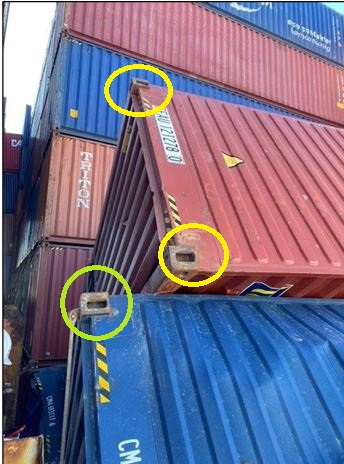I keep looking at the photo of the containers shifting on board the vessel.
I see that there are not stacking cones or twist locks between the containers.
no remnants or parts and the posts where the cones are to be installed are not damaged. NTSB got it wrong again
Here’s a link to the report: Container Loss aboard Containership President Eisenhower
To clarify: you think that because you’re not seeing twist locks in photos after the containers have gone overboard that the longshoreman, crew, officers, and NTSB all missed that there were none to begin with?
Just my observation
my experience is with Matson and several barge lines where stacking cones and twist locks are always used above the level of the cell guides.
what we have here is metal to metal contact only held with lashing rods.
Can You support your claim with screenshot or picture ??
I have blown up pics from the report to max and see semiautomatic t’locs where they should be.
LOOK AT THE PICTURES ON THE REPORT ON THIS SITE UNDER ACCIDENT.
I dont have to support nothing its a forum and this is my opinion based on 40years of experience as a marine surveyor
I keep looking at the photo of the containers shifting on board the vessel.
I see that there are not stacking cones or twist locks between the containers.
no remnants or parts and the posts where the cones are to be installed are not damaged. NTSB got it wrong again
[/quote]
Metal to metal contact is the corner posts stacked without cones or twist locks. the only thing holding the containers in place are the lashing rods.
YOU never allow metal to metal contact without cones or locks. THEY WILL SLIP.
the marine NTSB is not like the FAA NTSB. FAA is made up of engineers and designers from the various aircraft companies who have a vested interest in there own planes and gain insight into other MFG.
we were asked to submit a resume to the Marien NTSB but was not interested as alot of the costs are born by the individual. Typically, inexperienced in most marine matters they have a tendency to parrot various agencies such as the USCG who has problems of there own, terribly overextending in their missions and little firsthand experience other than saving lives
The picture on page four doesn’t show the corner castings, so you can’t see whether or not there At twistlocks in place but the gap between container tiers in that picture is consistent with the flange height of a twistlock.
There are two pictures on page six. Both show twistlocks in that standing stacks. The picture on the right side includes a total of three corner castings, all in the top of containers that have fallen. Semi-auto locks normally hang from the bottom of containers.
There is nothing in any of the pictures to lead me to think that the locks were not there. Given how locks work I don’t think lack of damage to a few top corner castings is a strong indicator. I also question how long unlashed containers without stackers or twistlocks would have stayed on.
Looking at the page nine diagram of what containers were lost, it appears consistent with the overloaded/excess forces theory. The entire outboard stack went over and this is where acceleration forces would be highest as the vessel rolled. As you move inboard fewer container are lost until you get to an intact stack at the sixth cell inboard.
I don’t see anything to support strident claims that locks were missing.
Maybe look at the DNV Survey report from the docket showing damaged twistlock sockets on the posts in the cell in question, consistent with the twist lock being pulled out during the loss.
There are no photos with clear enough resolution showing the bottoms of the toppled remaining containers, but plenty showing twist locks present on other containers, including page four literally with arrows pointing to the twist lock in place.
The photo in section 1.3.1 shows the container below the triton box does not have stacking cones nor the container ending in 278-0 nor is there damage to the top or bottom of these containers at the corner posts or remnants of these items ever being there.
you can also see the lack of cones within the depth of the picture
You either have far better eyes or a better computer or something than I do.
To be continued…
Pic source: https://jtsb.mlit.go.jp/eng-mar_report/2024/2022tk0001e.pdf
Pic source: https://onderzoeksraad.nl/wp-content/uploads/2023/11/internationale_toedrachtsrapport_msc_zoe.pdf
Source: https://maiif.org/wp-content/uploads/2017/08/MAIIF-Manual-2014.pdf
Drawing conclusions basis scanty and insufficiernt information can be misleading and dangerous as reliance on scanty information while position making or collision avoidance.
Have seen and read much better and more detailed investigation reports then the one offered by NTSB.
For professional and armchair experts here is another piece of advise from local established and respected experts:
From section 1.3.1. areas marked yellow may cause an assumption it was o top (6th tier container) hence the only thing one may expect there is some gull shit instead of remanants of damaged t’locks or container corner post deformations.
However item marked green , where the lashing rod is attached indicates it is NOT a top tier container as lashing rods are not reaching higher then 3rd tier. In this place one could expect either bottom part of sheared t’lock or deformed corner post of pictured conteiner. None of these tale-telling signs of destructive force is present.
Unfortunately NTSB did not show enough pictures from different angles and/or positions what rather precludes firm & uncontestable conclusions basis one stupid picture alone.





